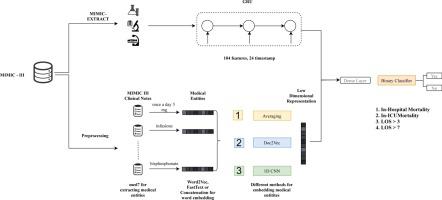Artificial Intelligence in Medicine ( IF 7.5 ) Pub Date : 2021-05-13 , DOI: 10.1016/j.artmed.2021.102112 Batuhan Bardak 1 , Mehmet Tan 1

|
Early prediction of mortality and length of stay (LOS) of a patient is vital for saving a patient's life and management of hospital resources. Availability of Electronic Health Records (EHR) makes a huge impact on the healthcare domain and there are several works on predicting clinical problems. However, many studies did not benefit from the clinical notes because of the sparse, and high dimensional nature. In this work, we extract medical entities from clinical notes and use them as additional features besides time-series features to improve proposed model predictions. The proposed convolution based multimodal architecture, which not only learns effectively combining medical entities and time-series Intensive Care Unit (ICU) signals of patients but also allows to compare the effect of different embedding techniques such as Word2vec and FastText on medical entities. Results show that the proposed deep multimodal method outperforms all other baseline models including multimodal architectures and improves the mortality prediction performance for Area Under the Receiver Operating Characteristics (AUROC) and Area Under Precision-Recall Curve (AUPRC) by around 3%. For LOS predictions, there is an improvement of around 2.5% over the time-series baseline. The code for the proposed method is available at https://github.com/tanlab/ConvolutionMedicalNer.
中文翻译:

使用多模态学习对医学实体进行卷积改进临床结果预测
早期预测患者的死亡率和住院时间 (LOS) 对于挽救患者生命和管理医院资源至关重要。电子健康记录 (EHR) 的可用性对医疗保健领域产生了巨大影响,并且有几项用于预测临床问题的工作。然而,由于稀疏和高维的性质,许多研究并没有从临床记录中受益。在这项工作中,我们从临床记录中提取医学实体,并将它们用作时间序列特征之外的附加特征,以改进提议的模型预测。提出的基于卷积的多模态架构,它不仅可以学习有效地结合医疗实体和患者的时间序列重症监护室 (ICU) 信号,还可以比较 Word2vec 和 FastText 等不同嵌入技术对医疗实体的影响。结果表明,所提出的深度多模态方法优于包括多模态架构在内的所有其他基线模型,并将接收器操作特性下面积 (AUROC) 和精确召回曲线下面积 (AUPRC) 的死亡率预测性能提高了约 3%。对于 LOS 预测,比时间序列基线提高了约 2.5%。所提议方法的代码可在 https://github.com/tanlab/ConvolutionMedicalNer 获得。结果表明,所提出的深度多模态方法优于包括多模态架构在内的所有其他基线模型,并将接收器操作特性下面积 (AUROC) 和精确召回曲线下面积 (AUPRC) 的死亡率预测性能提高了约 3%。对于 LOS 预测,比时间序列基线提高了约 2.5%。所提议方法的代码可在 https://github.com/tanlab/ConvolutionMedicalNer 获得。结果表明,所提出的深度多模态方法优于包括多模态架构在内的所有其他基线模型,并将接收器操作特性下面积 (AUROC) 和精确召回曲线下面积 (AUPRC) 的死亡率预测性能提高了约 3%。对于 LOS 预测,比时间序列基线提高了约 2.5%。所提议方法的代码可在 https://github.com/tanlab/ConvolutionMedicalNer 获得。


























 京公网安备 11010802027423号
京公网安备 11010802027423号